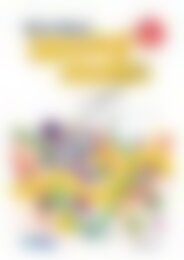20771_Problem_solving_Year_6_Background_information_resources
You also want an ePaper? Increase the reach of your titles
YUMPU automatically turns print PDFs into web optimized ePapers that Google loves.
INTRODUCTION<br />
<strong>Problem</strong>-<strong>solving</strong> and mathematical thinking<br />
By learning problem-<strong>solving</strong> in mathematics,<br />
students should acquire ways of thinking,<br />
habits of persistence and curiosity, and<br />
confidence in unfamiliar situations that will<br />
serve them well outside the mathematics<br />
classroom. In everyday life and in the<br />
workplace, being a good problem solver can<br />
lead to great advantages.<br />
NCTM principles and standards for school<br />
mathematics<br />
(2000, p. 52)<br />
<strong>Problem</strong>-<strong>solving</strong> lies at the heart of mathematics.<br />
New mathematical concepts and processes have<br />
always grown out of problem situations and students’<br />
problem-<strong>solving</strong> capabilities develop from the very<br />
beginning of mathematics learning. A need to solve a<br />
problem can motivate students to acquire new ways<br />
of thinking as well as to come to terms with concepts<br />
and processes that might not have been adequately<br />
learned when first introduced. Even those who can<br />
calculate efficiently and accurately are ill prepared for<br />
a world where new and adaptable ways of thinking<br />
are essential if they are unable to identify which<br />
<strong>information</strong> or processes are needed.<br />
On the other hand, students who can analyse problem<br />
meanings, explore means to a solution and carry<br />
out a plan to solve mathematical problems have<br />
acquired deeper and more useful knowledge than<br />
simply being able to complete calculations, name<br />
shapes, use formulas to make measurements or<br />
determine measures of chance and data. It is critical<br />
that mathematics teaching focuses on enabling all<br />
students to become both able and willing to engage<br />
with and solve mathematical problems.<br />
Well-chosen problems encourage deeper exploration<br />
of mathematical ideas, build persistence and highlight<br />
the need to understand thinking strategies, properties<br />
and relationships. They also reveal the central role of<br />
sense making in mathematical thinking—not only to<br />
evaluate the need for assessing the reasonableness<br />
of an answer or solution, but also the need to consider<br />
the inter-relationships among the <strong>information</strong> provided<br />
with a problem situation. This may take the form of<br />
number sense, allowing numbers to be represented<br />
in various ways and operations to be interconnected;<br />
through spatial sense that allows the visualisation of<br />
a problem in both its parts and whole; to a sense of<br />
measurement across length, area, volume and chance<br />
and data.<br />
<strong>Problem</strong>-<strong>solving</strong><br />
A problem is a task or situation for which there is<br />
no immediate or obvious solution, so that problem<strong>solving</strong><br />
refers to the processes used when engaging<br />
with this task. When problem-<strong>solving</strong>, students engage<br />
with situations for which a solution strategy is not<br />
immediately obvious, drawing on their understanding<br />
of concepts and processes they have already met, and<br />
will often develop new understandings and ways of<br />
thinking as they move towards a solution. It follows<br />
that a task that is a problem for one student may not<br />
be a problem for another and that a situation that<br />
is a problem at one level will only be an exercise or<br />
routine application of a known means to a solution at<br />
a later time.<br />
A large number of tourists visited Uluru during 2007.<br />
There were twice as many visitors in 2007 than in<br />
2003 and 6530 more visitors in 2007 than in 2006. If<br />
there were 298 460 visitors in 2003, how many were<br />
there in 2006?<br />
For a student in <strong>Year</strong> 4 or <strong>Year</strong> 5, sorting out the<br />
<strong>information</strong> to see how the number of visitors each<br />
year are linked is a considerable task. There is also<br />
R.I.C. Publications ® www.ricpublications.com.au <strong>Problem</strong>-<strong>solving</strong> in mathematics<br />
vii

















